Dr. Michal Sobotka, from the Astronomical Institute of the Czech Academy of Sciences, introduces us to solar pores in our latest post of #TheScienceofEST series.
 Solar pores in active region NOAA 11516. The image was obtained with the Vacuum Tower Telescope in Tenerife on 2012 July 1 at 430 nm.
Solar pores in active region NOAA 11516. The image was obtained with the Vacuum Tower Telescope in Tenerife on 2012 July 1 at 430 nm.
Pores are “naked” sunspots without a penumbra. A pore appears when a strong magnetic field emerges through the solar surface and inhibits the convective transfer of heat from lower layers - that is why pores look dark. If the magnetic flux increases, the field becomes strongly inclined at the edge of the pore, the penumbra is formed, and the pore transforms into a sunspot.
Pores -which are themselves “small” (1000 - 6000 km in diameter)- include much smaller bright structures, which indicate that the convective heat transfer from below is not completely suppressed. Dispersed magnetic fields around the pores also produce small bright points and chains in lanes between solar granules.
Thanks to their relatively simple magnetic-field configuration, pores are a good opportunity to study interactions between the magnetic field and moving plasma. Since such processes take place on very small spatial scales, the extremely high resolution of tens of kilometers, provided by the European Solar Telescope, will be fully utilized.
